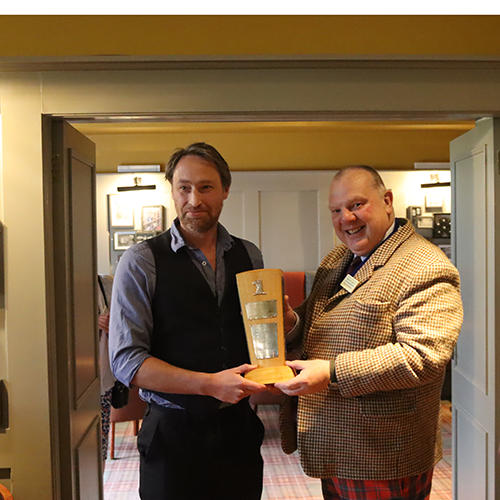Prize-winning research prompts effort to restore elm tree populations
AN award-winning article by an academic at UHI Inverness on research into Dutch elm disease has prompted plans for a collaboration with the Royal Botanic Garden Edinburgh to protect and restore elm tree populations.

Dr Euan Bowditch, a lecturer at the Scottish School of Forestry and a researcher based at the Inverness campus, was the lead author of the paper “The elm is dead! Long live the elm! New developments for elm conservation in Scotland”. The co-author was Elspeth MacDonald, a former Scottish School of Forestry lecturer. The paper was published last summer in Scottish Forestry, the journal of the Royal Scottish Forestry Society (RSFS).
It has been awarded the Sir George Campbell Memorial Trophy for the best professional paper published in the journal in 2021. The winning paper was selected by an independent panel of three judges who described it as being of “international importance”. The prize was presented to Dr Bowditch by RSFS President Simon MacGillivray during the society’s recent annual study tour.
The article discusses the status of Dutch elm disease in Scotland and the recent foothold of the disease in the Highlands. It draws on a wide variety of research techniques to provide new information on the current state of Scottish elms and suggests strategies for future conservation.
Elms across the world have been ravaged by Dutch elm disease, but resistance is thought to exist as healthy trees continue to survive next to infected trees and woodlands, which could form the base of future resilience.
Dr Bowditch said: “The paper looks at our current knowledge of the elm species. It asks if there are any healthy elm populations still thriving, where the biggest impact of Dutch elm disease is, and where the disease is going, because it is obviously still travelling across the Highland landscape.
“It looks at different populations and the potential for refuges across the Highlands to monitor the spread and the potential resilience. It suggests looking at surviving and healthy individuals that are in hard-hit areas further south, spreading Dutch elm disease since the 1960s, and identifying those individuals and looking at ways that we can introduce resilience and restore elm to the landscape.”
Dr Bowditch added: “The upshot of the paper and previous work is connecting with other organisations that have an interest in building the knowledge around elm and Dutch elm disease, which has led to the formation of a ‘native elm group’ that is committed to collaborating on short and long-term efforts to restore the elm.
“This can lead to collaborations with organisations such as the Royal Botanic Garden Edinburgh, which will increase capacity to undertake larger scale projects on resilient elms, genetics work and restoration strategies.”
The Royal Botanic Garden Edinburgh’s Science Communicator, Dr Max Coleman, said: “The idea is to find what could be resilient individuals, as indicated by their size and presence in areas of heavy disease and propagate those as the basis of new populations to be planted on protected land. These could then begin to spread naturally over time.”
Dr Coleman added that one area of interest is the genetic basis of resilience.
“What we can look at doing in the near future is to compare populations of survivors in the south of Scotland with populations untouched by disease in the Highlands to begin to look for genetic differences and to see what impact disease has had on genetic diversity of the wych elm,’ he said.
Scottish Forestry editor Gavin McGregor said: “We were delighted to publish work of the quality and influence of Euan and Elspeth’s article detailing the fascinating work being done to restore and preserve our iconic elm species. The society’s educational mission of sharing knowledge and experience among forestry and woodland professionals and the wider public is greatly enriched by our relationship with writers of such expertise.”
Dr Bowditch is a member of the expert panel at Forest Europe in Sweden which convened this summer. Forest Europe is a high-level forest policy process made up of 50 countries which aims to develop common strategies to protect and sustainably manage forests.